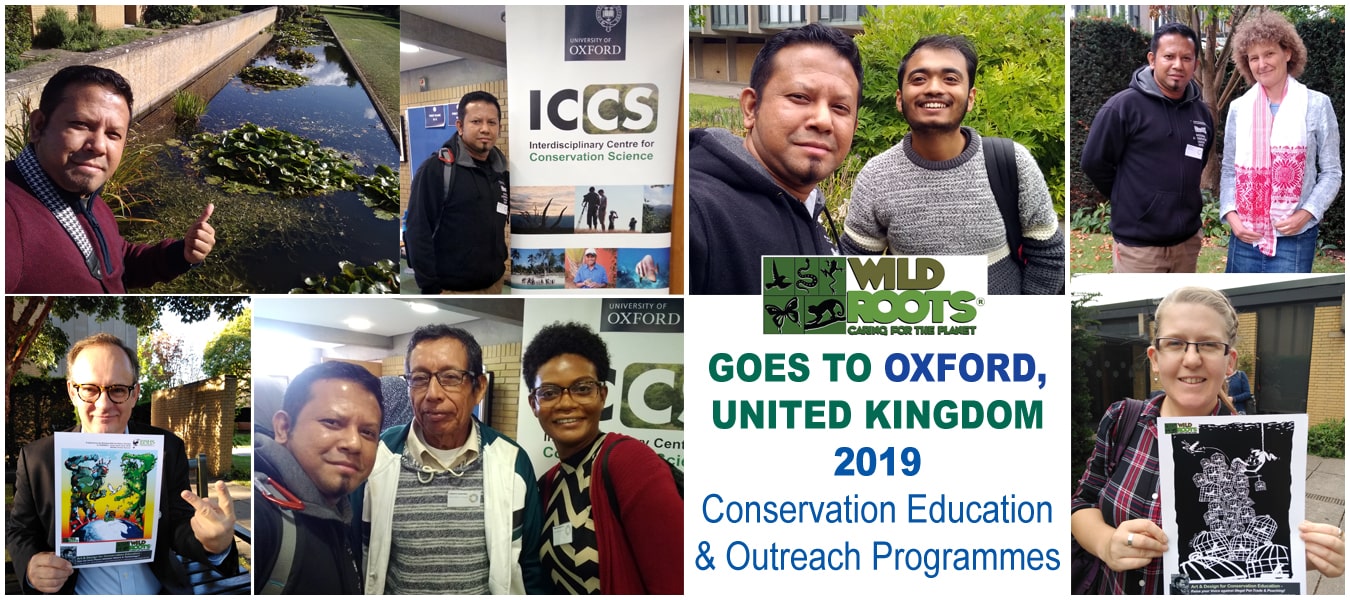
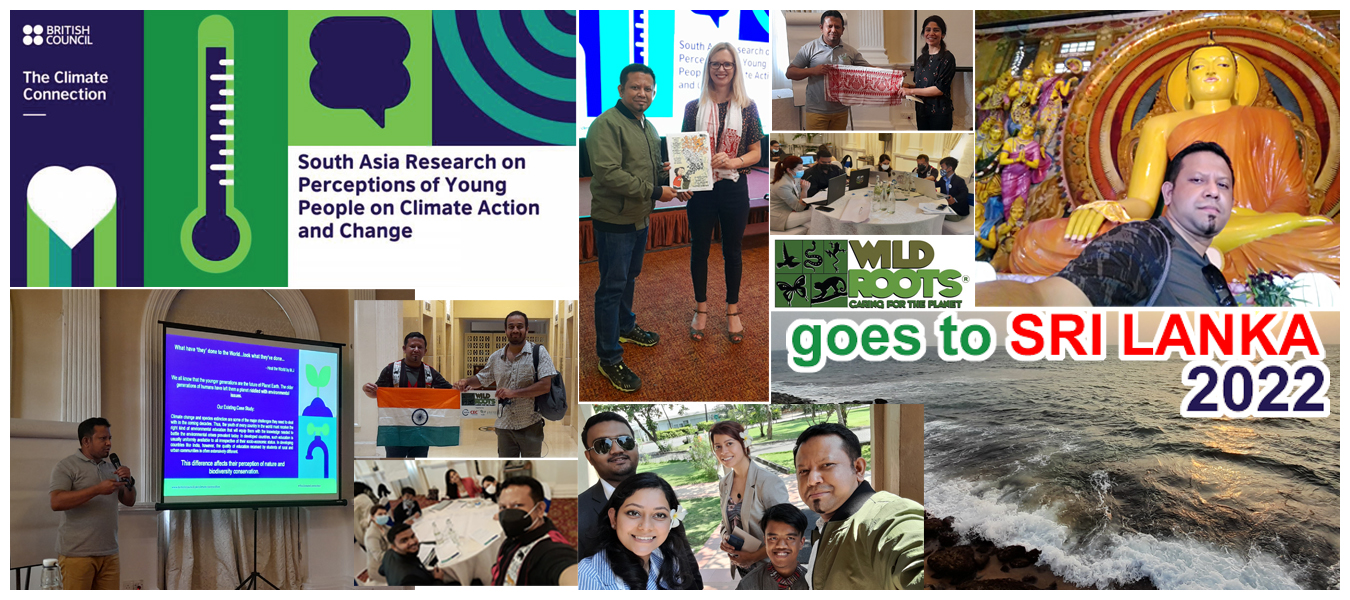
|
As a part of educational and awareness programme in line to save the Critically Endangered bird, White-bellied Heron, a day long advocacy to the students and staff of Norbugang school, Tsirang was conducted on 19th May, 2018. RSPN decided for this programme to consider in this school for being most of the students residing in the close catchment area where heron is frequently sighted. As a part of the programme, ardent birder and conservationist Mr. Tshering Tobgay was invited to collaborate with RSPN staff Mr. Sonam Tshering in delivering the message.  A session began with introducing physical structure, morph, behavior, habitat preference, niche and the IUCN status of White-bellied Heron. As an instructional medium, poster presentation and power point were used. Mr. Sonam added in between to share about the conservation work RSPN is carrying out to save this species of bird. Students were really excited when Sonam precisely described with steps of life cycle process of captive breeding RSPN has conducted earlier for this bird in Punakha. 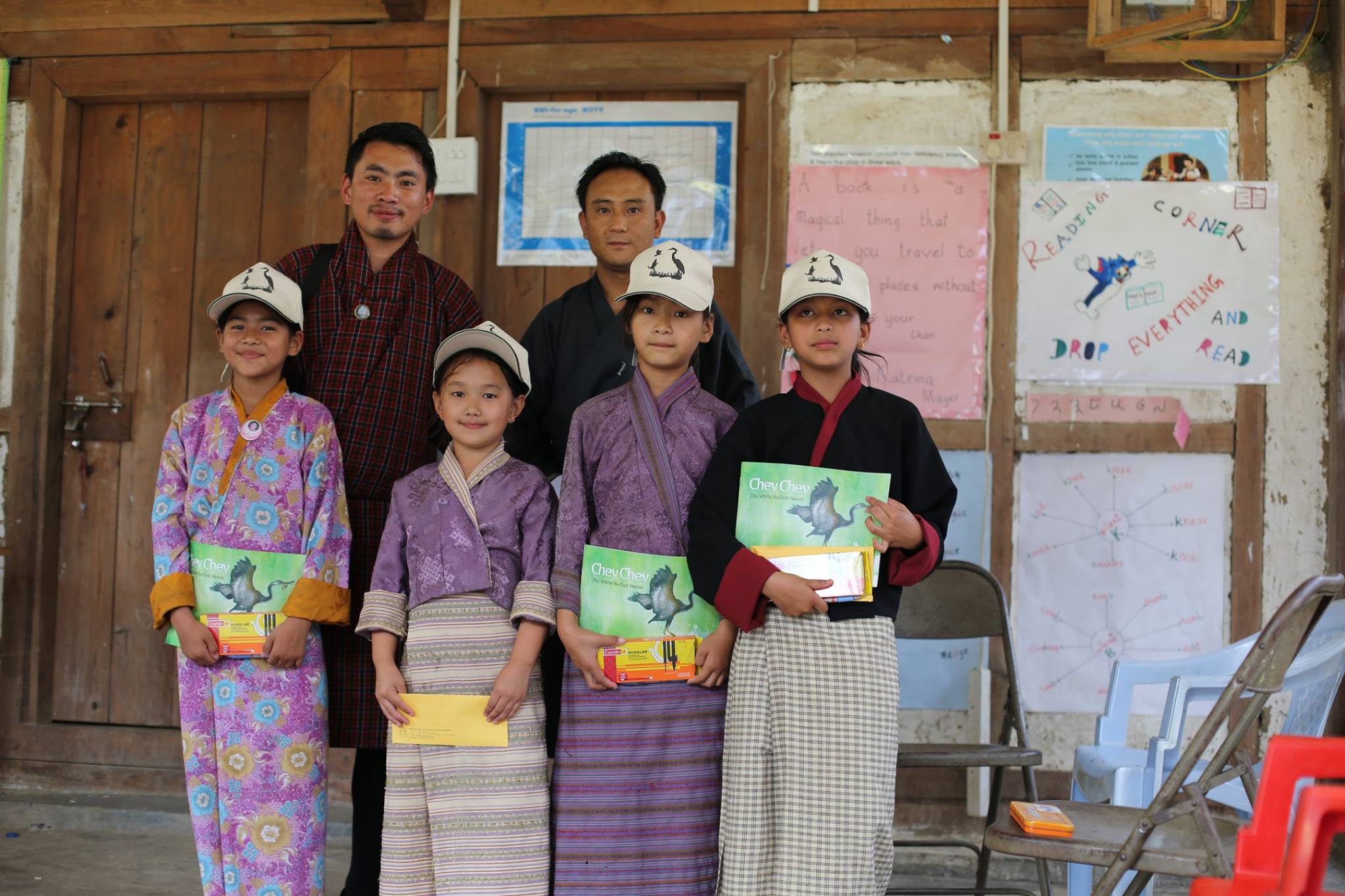 Session also covered the threats to this bird and it is really overwhelming to get good response from the youth and their commitment in minimizing the threats in saving the Heron. They are assured ambassador for RSPN’s Heron conservation team. Later, as a part of session to understand the instant positive impact of the lesson shared, drawing competition on theme ‘What can you do save White-bellied Heron?’ was held. Top drawings were awarded with prizes and the programme was ended with thankful note from host school teacher. - WildRoots commends Tshering Tobgay for his efforts! |
|
Very honestly speaking, my knowledge about Raptors (https://en.wikipedia.org/wiki/Bird_of_prey) was very less and to design programmes based on Raptor Conservation for WildRoots, I myself needed to know much aspects about these 'masters of the air'. But, as some people wrongly believe, one can't know about these wonderful birds if one is not associated with hardcore scientific research, wildlife biology or conservation. That notion is completely wrong. We are in the Digital Information age where information about anything is at a stone's throw reach, if only one plans intelligently to use the enterprising connections that one makes in life, through self study, research and most importantly...travel. I read a lot. But somewhere, mere books, publications, research papers, birding hikes and wildlife safaris to place like Kaziranga National Park, Assam seemed inadequate in providing me with an in-depth knowledge about the birds of prey. I wanted to study them up close, being a 'lay-man' who just wanted to know more. Welcome to the Eagles Heritage Wildlife Centre, Margaret River, Australia The Free Area inside the Centre which offers a chance to the visitors to observe the raptors in the wild. 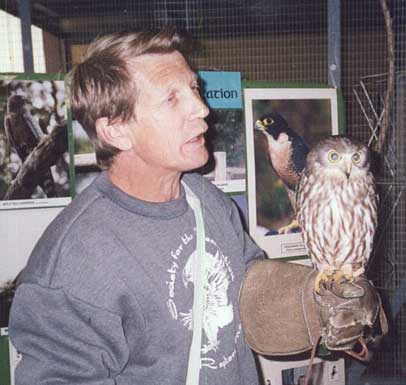
Philip Pain, the Society's Coordinator, founded the group in 1984 in order to promote networking and cooperation amongst likeminded specialist raptor rehabilitators. The Society is made up of a group of genuinely dedicated people, young and old, from all walks of life, who give their time and effort to work in their chosen area of wildlife care - raptors. The members are also involved in educational talks and public displays for schools, community groups, fetes and fairs. Philip Pain is also the owner/curator of the Eagles Heritage Raptor Wildlife Centre, a qualified zoo keeper with over thirty years' experience in raptors and a recipient of a Churchill Fellowship in 1986. (Photo obtained from The Society for the Preservation of Raptors Inc.)
2. Food is often swallowed whole – bits of fur and bone are then regurgitated (coughed up) as an owl pellet. 3. Barn Owls screech – they never hoot! 4. The scientific Latin name for Barn Owl is Tyto alba alba. 5. Barn Owls have very long legs, toes and talons to help them to catch prey hidden under long grass. Each Talon is capable of exerting 50pounds of pressure on the prey. Wow! 6. Barn Owls usually hunt at night – even in total darkness they can find the smallest vole using their super-sensitive hearing. 7. Barn Owls’ large eyes are very sensitive too – they can quickly spot a mouse moving in a very gloomy barn. 8. Barn Owl feathers are super soft – this helps them to hunt silently, but they are not very waterproof and get soaked if it rains. 9. Barn Owls have lop-sided ears! One is higher than the other, which helps them to pinpoint exactly where tiny sounds are coming from. 10. A wild Barn Owl usually eats about 4 small mammals every night, that’s 1,460 per year! That's makes these owls super pest control machines....:-) 2. The feathers on the edge of a Barn Owl’s heart shaped face create a disc, which works to trap and focus sound, rather like our outer ears. 3. Owl ears are each shaped differently from one another are placed not side by side. This gives the owls 3-Dimensional Hearing. One ear is higher than the other. 4. Barn Owl ears are hidden in the feathers at the side of the face 5. During flight, the left ear captures sounds below, whilst the right ear focuses on sounds from above. 6. The Barn Owl’s 2 different ears allow the owl’s brain to work out exactly where its prey is hiding – even in the dark or under long grass. 7. A Barn Owl’s very soft feathers enable silent flight – so the owl can listen out for tiny sounds from voles or mice 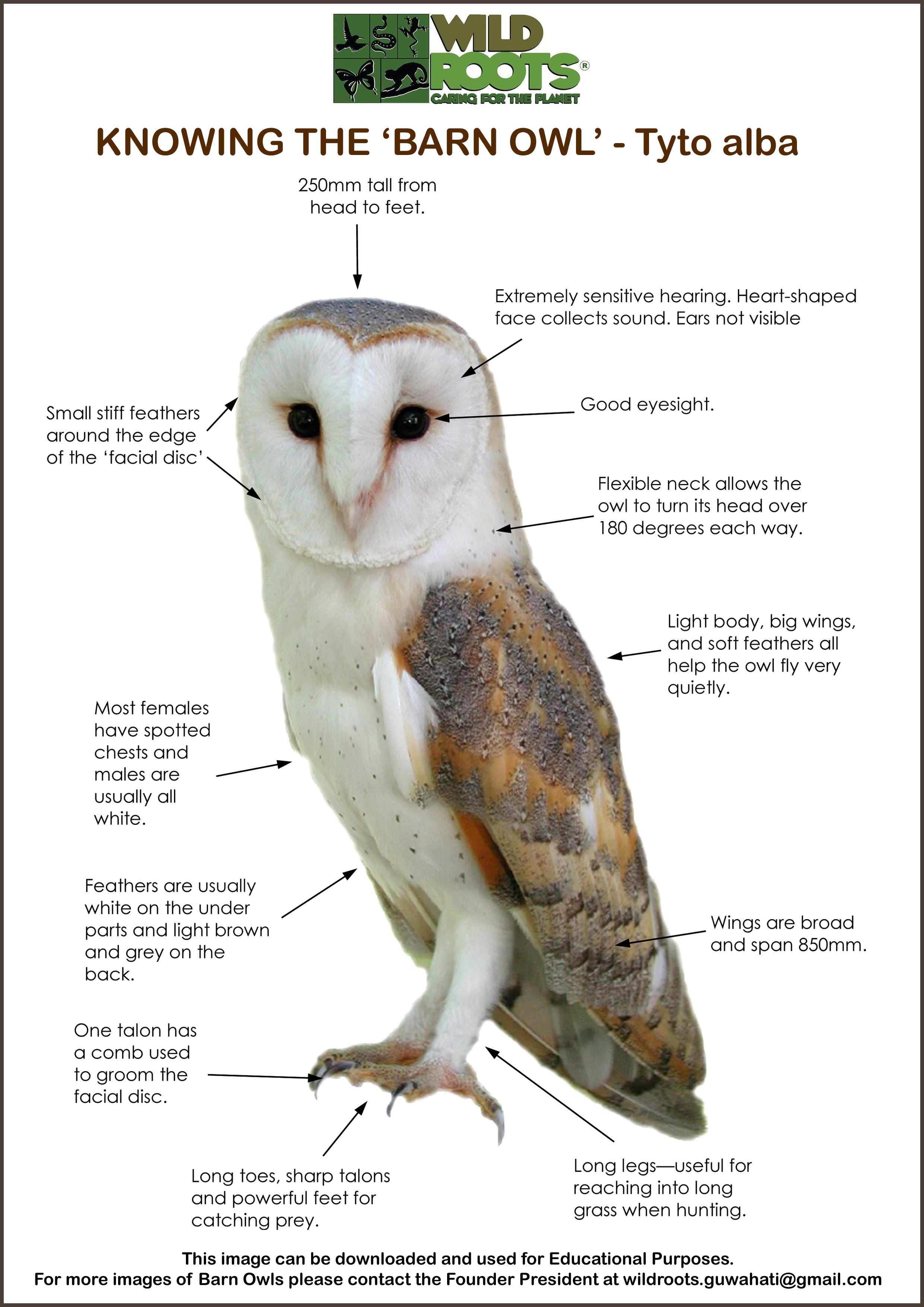
- March 01, 2018 : Biswajit De, Founder President, WildRoots |
|
During the year 2015, Mr. Biswajit De, Founder President, WildRoots, got an amazing opportunity to be a part of the Wildlife Habitat Education Programme and the WVU Extention Master Gardner Programme at the Yankauer Nature Preserve, West Virginia, USA. This was planned as a part of the Service Projects which were organized by the US Fish & WildLife Service through the Educational Venture of the National Conservation & Training Center, Shepherdstown, West Virginia, USA during the Student Climate Corps. & Conservation Congress, 2015. .jpg)
.jpg)
Mr. De was the first Indian to be a part of the 'Wildlife Habitat Education Programme' and the 'WVU Extension Master Gardener Programme' and carry forward the ideas and learning outcomes through the Sustainable Design Projects undertaken by WildRoots during the following years. .jpg)
.jpg)
.jpg)
• To teach the youth basic life skills, including teamwork, leadership, oral and written communication skills, media skills and ICT, critical thinking skills and constructive competition. • Introduce the youth to the diversity of ecosystems, natural resource professions, cultures and recreational opportunities not only in the US but also in the other countries. • Identification of Invasive Plant Species and their removal from Wildlife Gardens. The WVU Extension Master Gardener Program provides people interested in wildlife and pollinator friendly gardening with the opportunity to expand their knowledge and sharpen their skills by taking part in Basic & Advanced Level training programs that provide in-depth training in various aspects of horticulture. The program helps educators and students better understand horticultural and environmental issues through community engagement in gardening and beautification projects at schools, parks, public institutions, community organizations, and locations all over the world. .jpg) Founder President with Virginia & Eldon Winston during the training programme As Eldon had put it - 'We have to save the Bees, Butterflies and other Pollinators like the Bats. These hard-working animals help pollinate over 75% of our flowering plants, and nearly 75% of our crops. Often we may not notice the hummingbirds, bats, bees, beetles, butterflies, and flies that carry pollen from one plant to another as they collect nectar. Yet without them, wildlife would have fewer nutritious berries and seeds, and we would miss many fruits, vegetables, and nuts, like blueberries, squash, and almonds . . . not to mention chocolate and coffee…all of which depend on pollinators'. .jpg)
.jpg) Eldon & Virginia explaining the participants about the importance of Pollinators at the Yankauer Nature Preserve, West Virginia, USA WHY POLLINATORS ARE IMPORTANT? Pollinators, such as most bees and some birds, bats, and other insects, play a crucial role in flowering plant reproduction and in the production of most fruits and vegetables. Examples of crops that are pollinated include apples, squash, and almonds. Without the assistance of pollinators, most plants cannot produce fruits and seeds. The fruits and seeds of flowering plants are an important food source for people and wildlife. Some of the seeds that are not eaten will eventually produce new plants, helping to maintain the plant population. In the United States pollination by honey bees directly or indirectly (e.g., pollination required to produce seeds for the crop) contributed to over $19 billion of crops in 2010. Pollination by other insect pollinators contributed to nearly $10 billion of crops in 2010. A recent study of the status of pollinators in North America by the National Academy of Sciences found that populations of honey bees (which are not native to North America) and some wild pollinators are declining. Declines in wild pollinators may be a result of habitat loss and degradation, while declines in managed bees is linked to disease (introduced parasites and pathogens). Being a part of the training programme, Mr. De tried to identify the issues faced by the habitats in the US and tried to compare them with the habitat loss which is happening in India and had a wonderful opportunity to learn about the various means to sensitize people and come out with collective solutions for various Global Problems, which are posing a great threat to the pollinators. Much of the WildRoots Citizen Science Modules for the Conservation of the Pollinators like Bees, Butterflies and the Bats, as initiated a couple of years back in North East India, would be based on his learning outcomes from the Habitat Education Programme and the WVU Extention Master Gardner Programme. WildRoots would strive to learn more about the Conservation of Pollinators through its participation in such training programmes, over the next few years. Stay tuned for our Urban Habitat Design and Sustainable Design Models which would soon be visible all over Assam and in the other States of North East India. - A report by the WildRoots Team! |
ABISKO NATIONAL PARK, SWEDENI was beginning to wonder why my synoptic senses were in a disarray! Was it the long Swedish winter. Or was it just me being myself. Eyes strained. Back ached. Fingers were jittery. One such day at the office, with a coffee in hand, I was overlooking a parking lot from my office window. It was raining in bits and pieces with gusts of the wind from time to time. Little specs of rain drops hit the window pane hard and revolted in uncharacteristic chatter. Beyond the windowpane was a gray parking lot in front of dull gray old buildings with a dull overcast gray sky. My mind was equally the same.It was on such a day that I remembered Aurora. Aurora Borealis, sometimes referred to as polar lights or northern lights, is a natural light display in the sky, predominantly seen in the high latitude (Arctic and Antarctic) regions. Auroras are produced when the magnetosphere is sufficiently disturbed by the solar wind that the trajectories of charged particles in both solar wind and magnetospheric plasma, mainly in the form of electrons and protons, precipitate them into the upper atmosphere (thermosphere/exosphere), where their energy is lost. The resulting ionization and excitation of atmospheric constituents emit light of varying color and complexity. The Aurora is an incredible light show caused by collisions between electrically charged particles released from the sun that enter the earth's atmosphere and collide with gasses such as oxygen and nitrogen. This is what it is in simple terms. Train tickets and hotel were booked. Destination, Abisko Tourist Station, in Abisko National Park, in the middle of nowhere. Abisko is a small town, around 1700 km from the city of Gothenburg, where I live. It’s an overnight journey, via Stockholm, the capital of Sweden. The train journey is very similar to overnight trains in India. When I say similar, I mean the bunk beds and all. As the train race through the Swedish winter landscape towards the Arctic Circle, the landscape changed gradually. From little snow to a tundra landscape covered with snow, innumerable frozen lakes. It was a fairy tale like a sight as the trained chugged along. There was a sense of exhilaration as we crossed the Arctic Circle. Finally, at about 11:30 A.M. the next day, we reached Abisko. .jpg) Abisko is a village in Lapland, in northern Sweden, roughly 250 km within the Arctic Circle, and near Abisko National Park, located 4 km west of the village. It is in this national park, there is a remote station called Abisko STF Tourist Station. This station is personnel less and has no station master. It’s just a station for the youth hostel bang opposite the platform. The remoteness and wilderness of the place is indescribable. And yet, the place is well connected by rail and road. Equally amazing is the youth hostel which has all kinds of facilities, though basic and yet loveable. Let me try to draw a picture of the place in your mind. If I stand on the single platform facing the hostel, to my left is Mt. Nuolja and towards the right is Abisko canyon, far stretching towards Kiruna and beyond. Imagine standing right at below of the summit of Mt. Nuojla (on top of which is Abisko Sky Station). There is a highway E10, which links the city of Kiruna in Sweden and Narvik in Norway, between the station and the youth hostel. The station is on a higher ground overlooking the road, beyond the road is the youth hostel. And far behind the youth hostel is the lake Torneträsk. Torneträsk is about 330 square kilometer (130 sq mi). Within this is The Abisko Turiststation, run by the Svenska Turistföreningen (STF), houses many visitors to the park and provides lodging, food, and other amenities. .jpg) Post lunch the day passed slowly. Anticipation and anxiety overtook us and an undercurrent of tension ran through our nerves. The thought of night sky made us restless. We have had heard stories of disappointed tourists and travelers returning back without even seeing a glimpse of the Aurora Borealis. Either they went through overcast skies or it was mostly that it just did not happen. It is a natural phenomenon that may not occur every day. But it seemed lady luck had found us that day. We saw the first glimpse of the northern lights at dusk. Needless to say the feeling. At 8:15 P.M., we waited eagerly at the hotel reception. Outside it was already -10 degrees centigrade. We were to be picked up by our guide for viewing northern lights. Sharp at 8:30 at night we were picked up taken to the edge of a forest in near the Abisko city. It was freaking cold outside already and temperatures will drop to 20 degrees below zero. We were given heavy winter clothing which included snow boots, hats, gloves and ski suits. These we wore on top of all the clothing we were already wearing. With so much clothing our movements became clumsy and with this clumsiness, we boarded a snowmobile driven six seated sleds. .jpg) As we drove through the dark Arctic forest, it was pitch dark with millions of stars staring down like diamonds in the sky. It was very cold but it didn’t bother us as we were awed what our eyes were soaking. A light cold breeze whistled through the forest and we were being taken deep into the forest. After about six to seven kilometers we stopped beside a frozen marsh and a small teepee. By that time the dancing lights had stopped and we eagerly waited for it to begin again. As we warmed ourselves around a fire inside the teepee, with a cup of hot coffee in our hands, we shared tit bits of our lives. We were six people inside the teepee. Our guide Philip, a middle-aged gentleman from Germany and four of us from India. It was getting cold outside. .jpg) .jpg) We were getting anxious and feared that our anxiousness might change into a heartbreak. It was already late and soon it would be time for us to leave. It would have been too cold to stay outside. My tripod and camera felt heavy. I had been waiting too long and my fingers were losing sensation. Then, just like that, it started. Aurora Borealis. The northern lights lit up the sky and started dancing like it was happening just for us. There was this tremendous sense of adrenalin rush that ran through the blood in our veins. The feeling was inexplicable. The whole sky was covered with bands of wavy lights. Mostly green but with red and violet in between sometimes. I became busy with my camera and others raved over the view that they were seeing. It went on for quite a while until it eased out a bit. And it was time for us to go back to our hostel. It was past 11:00 and we could feel the cold even with that much of clothing. It was almost -25 degrees centigrade. As we drove back home we kept staring up at the sky and couldn’t believe our luck. As we lay clumsily on our back, our hands were cold and our hearts were full. The sky was still intricately lit up and we were sort drifting into a trance. The snowmobile driven sled crawled through the forest. There was silence everywhere except the wind whistling past our ears. The cold dark arctic winter night looked down upon us with her amazing aura. .jpg)
.jpg)
.jpg)
The next day we had an early morning bus to the city of Kiruna about 100 km to the east. Kiruna, a mining city, is the northernmost town in Sweden, situated in the province of Lapland. Our aim was to visit the Ice Hotel in the village of Jukkasjärvi near Kiruna and take a dog sledding tour in the nearby forest. The ice hotel is in the village of Jukkasjärvi just beside the Torne River. Its first opening was in 1990; then the hotel has been rebuilt each year from December to April. The river is the core to the idea of ice hotel. The summers in Jukkasjärvi were popular among tourists, but the winters were long and cold. But, in the late 80’s, Yngve Bergqvist, who later founded Icehotel, got an idea. Inspired by the Japanese ice sculpting tradition and with the help of two professional ice sculptors from Japan as instructors; he invited artists to attend a workshop in Jukkasjärvi in 1989. This marked the start of a more than two decade long journey with the Torne River- the world’s first hotel made of ice and snow. The hotel, including the chairs and beds, is constructed from snow and ice blocks were taken from the nearby Torne. Artists are invited to create different rooms and decorations made by ice. Besides bedrooms, there is a bar, with glasses made of ice and an ice chapel that is popular with marrying couples. The structure remains below freezing, around −5 °C (23 °F). The building blocks are ice blocks cut straight from the frozen Torne River. The opaqueness of the ice depends upon the depth it was cut from and also how briskly water flowed. Though, today, ice blocks are made artificially by compressing snow and ice together. They call it “snice” (snow + ice). Ice blocks from the river are mostly used for sculpting. Now they have built a hotel called ICEHOTEL 365. As the name suggests, it now open 365 days a year. It’s basically a giant refrigerator with rooms in it. .jpg)
.jpg)
It was very cold outside even with the sun shining bright and blue sky. And yes, it was warmer inside the ice hotel. Each of the rooms is a work of art and had a theme of its own. Almost everything was made out of ice. From beds to chairs and even the chandeliers. The ice chandeliers are of the attractions. As we entered the ice hotel, we could see the chapel at the far end of the corridor. This is where weddings take place though very in brief and quick. Time passed by very quickly and soon it was time for the dogs. .jpg)
.jpg)
.jpg)
.jpg)
We were again all dressed up in heavy clothing. Ice hotel staff gave us with the extra clothing for the dog sledding trip. The trip will take us over the frozen Torne River and take us deep into a nearby forest. From very far away we could hear the yelping of the huskies. Husky is a dog breed and its origin is mostly Siberia or Alaskan. These were Alaskan Huskies, or more precisely Alaskan Malamute. They were originally bred for hauling heavy freight because of their strength and endurance, and later a sled dog. We were ushered to a four seated sleigh with the driver, called a musher, behind us. So off we went over the frozen Torne and arctic landscape towards the forest. Initially, it did feel comfortable with all the clothes we were wearing. The snow boots were tight and gloves were huge. It was getting difficult for me to operate the camera. But once we started, we forgot everything. We were as thrilled as the dogs. Once we entered the forest it was magical. Straight out of a fairytale forest. With fluffs of snow hanging from pine trees like cotton. It was simply breathtaking. We reached our destination. It was a small hut beside a frozen swamp but it looked more like a frozen field. This was the time we met each of the dogs and patted and befriended them. There were twelve of them pulling us. Each of them was adorable and very friendly. One of them I remember was named Rambo as it was bigger in size than the rest. The stronger dogs are always placed at the end of the line in front of the sleigh. Assembling a dog sled team involves picking leader dogs, point dogs, swing dogs, and wheel dogs. The lead dog is crucial, so mushers take particular care of these dogs. Another important detail is to have powerful wheel dogs to pull the sled out from the snow. Point dogs (optional) are located behind the leader dogs, swing dogs between the point and wheel dogs, and team dogs are all other dogs in between the wheel and swing dogs and are selected for their endurance, strength, and speed as part of the team. Very soon it was time for us to leave. We went back the same route we came. Through the forest and over the frozen Torne river. The day was coming to an end. We have to travel back 100kms to Abisko. .jpg)
.jpg) .jpg)
.jpg)
The star-studded sky lay in front of me in the vast openness of the Abisko National Park. The vast lake Torneträsk lay frozen in front of me. The calmness and coldness of the night engulfed me as a blanket as I stood watching the stars. We had come back to the youth hostel in Abisko. Just in two days, I managed to achieve what others couldn’t in weeks. Luck was on my side. There was happiness in my heart and yet it was sad. Next morning I had to board the train back home. It was a long journey back and certainly a saddened one. Saddened by the thought of the daily grind. But I saw a shooting star in the meantime. Like a quick streak across the starry sky. Brilliant and brief. Legend has it that wishing upon a shooting star makes the wish come true. And I wished that nature will not seize to amaze me. The morning of my departure seemed to come too fast. It was bright and sunny. Hardly a weather to be left behind for worse. A solitary sofa beside a window with a view lay unoccupied. As if inviting me to stay there for the rest of my life. But as a wise man said, everything that has a beginning has an end and nothing is permanent. So with a heavy heart, we checked out around 10:00 A.M. with our reluctant legs dragging us towards the station. The station was deserted. The only platform had just us in the beginning. Then other travelers started trickling in. In the distance I saw the train quietly approaching us like a serpent ready to devour us and rob us of our happy times. It was indeed so. Within minutes our journey back started. My best travelling experience till date. Nature, at its best. As train whizzed past the Lapland landscape, I began to ponder upon the memories and experiences I had. Nature is a great teacher and a healer. It’s the source of wisdom, as well as medicine. Wisdom for the parched traveler and medicine for the restless soul. Such amazement will always inspire me to take on new endeavors to find nature’s wisdom. I have with me a kiss of Aurora; mindful of memories and camera full of picture. You can erase the pictures but not the deeply etched memories. .jpg)
.jpg)
.jpg)
|
